There'll be something for everybody in 2019, with total, annular, and partial solar eclipses — and total and partial lunar eclipses to look forward to.
Up to seven eclipses of the Sun and Moon can take place in one year, though the last time that happened was 1982, and the fewest possible is four. The mix of five events occurring in 2019 is especially interesting, because no two will be alike! There'll be three different types of solar eclipse — one each of partial, annular, and total — along with a total and a partial lunar eclipse.
Why Do Eclipses Happen?
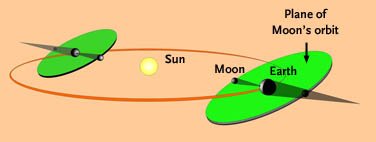
Jay Anderson
A solar eclipse, such as the one in August 2017, occurs only at new Moon, when the lunar disk passes directly between us and the Sun and the Moon's shadow falls somewhere on Earth's surface.
Conversely, a lunar eclipse takes place during full Moon, when our satellite passes through Earth's shadow.
These alignments don't happen at every new and full Moon because the lunar orbit is tipped about 5° to Earth's orbital plane — only occasionally do the Sun, Earth, and Moon line up exactly enough for an eclipse to occur. (The technical name for that, by the way, is syzygy.) And, as the diagram above implies, those alignments occur roughly six months apart. In 2019, for example, two eclipses occur in January, two in July, and one in late December.
Three types of lunar eclipse are possible (total, partial, and penumbral) depending on how deeply the full Moon plunges into or near the umbra, our planet's dark, central shadow.
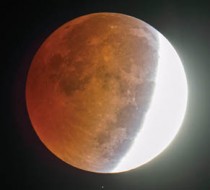
Johnny Horne
If it goes all the way in, we see a total lunar eclipse that's preceded and followed by partial phases. That was the case during the widely viewed event in September 2015, which marked the conclusion of a series of four consecutive total lunar eclipses in 2014–15! Such eclipse tetrads are not common — the last one occurred during 2003–04, but the next won't begin until 2032.
If the Moon skims part way into the umbra, as shown at right, only the partial phases occur — you'll see part of the Moon in nearly full sunlight, and part of it steeped in the deep, red-tinged umbral shadow.
And if its disk passes just outside the umbra, it still encounters the weak penumbral shadow cast by Earth. A sharp-eyed observer will notice that one side of the full Moon's disk looks a little dusky.
Fortunately, every lunar eclipse is observable anywhere on Earth where the Moon is above the horizon. (But there's still an element of luck involved — after all, the sky has to be clear!)
However, solar eclipses more tightly restrict where you can see them because the Moon casts a smaller shadow than Earth does.
If the Moon completely hides the Sun, the eclipse is considered total. With its brilliant disk completely covered, the Sun's ghostly white outer atmosphere is momentarily revealed for durations from seconds to several minutes. In November 2013, for example, planeloads of eclipse-chasers converged in a remote portion of northern Kenya to watch just 11 seconds of totality.
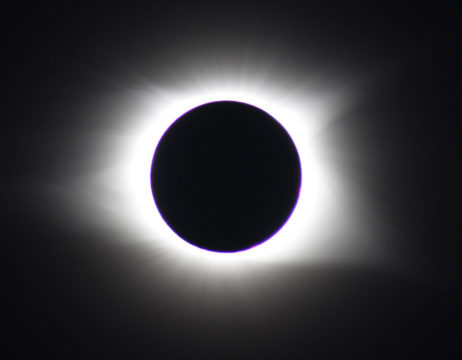
Sky & Telescope / Kelly Beatty
A completely eclipsed Sun can be viewed only from a narrow track or path on Earth's surface that's typically just 100 miles (160 km) wide. Outside of that path, about half of the daylit hemisphere of Earth is able to watch a partial eclipse as the Moon obscures a portion of the Sun.
Occasionally the Moon passes directly in front of the Sun but doesn't completely cover it. When that occurs, it's usually because the Moon is farther from Earth than its average distance. (The Moon's orbit isn't perfectly circular; its eccentricity is about 5%.)
This geometric circumstance is known as an annular eclipse, so-called because you can see a ring, or annulus, of sunlight surrounding the lunar disk. Annular eclipses of the Sun occur about as often as the total ones do, and an annular's path is likewise narrow. Outside of it observers see only a partial cover-up.
The Five Eclipses in 2019
Below are brief descriptions of this eclipses in 2019 of the Sun and Moon. You'll find more details Sky & Telescope magazine as the date of each draws near. Times are in Universal Time (UT) except as noted. Adjust these to get those for your time zone: for example. PST = UT – 8, and EST = UT – 5. (But be sure to allow for daylight or "summer" time: PDT = UT – 7, and EDT = UT – 4.)
January 6: Partial Solar Eclipse
The year starts off with a bang, eclipse-wise, with a partial solar eclipse during the first week of January. But to see the Moon take its biggest bite out of Sun — the location of greatest eclipse — you'll need to venture to the bleak outpost of Srednekolymsk in central Siberia. (Hey, at least it's got an airport.) There you'll brave an average daytime high of –28°F to witness 62% of the Sun's disk tuck behind the Moon. The obscuration and the weather are less dramatic elsewhere in northeastern Asia and the North Pacific Ocean. About 20% of the Sun is covered from Beijing, 30% from Tokyo, and 37% from Vladivostok. More information about this eclipse.
January 20–21: Total Lunar Eclipse
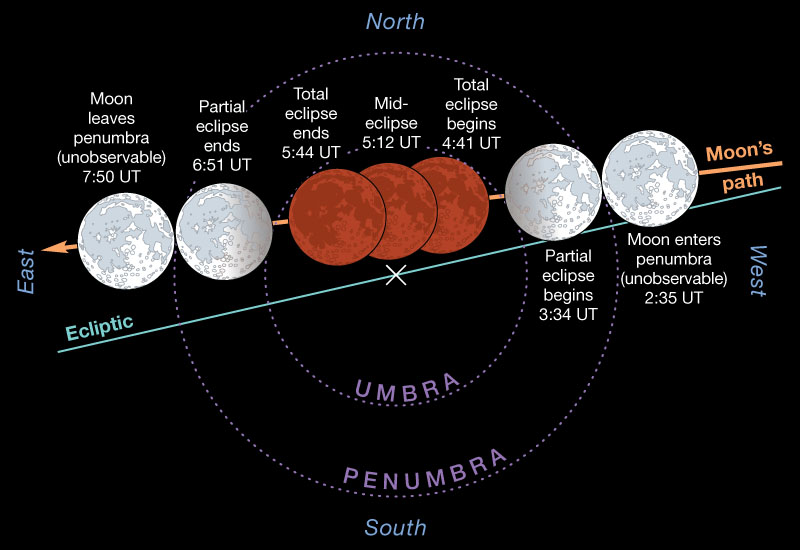
Leah Tiscione / Sky & Telescope
It's been more than three years since everyone in the U.S. has experienced a total lunar eclipse — the last one was September 27–28, 2015 — and skygazers are hungry for another! As the graphic at right shows, the eclipse will last almost 3½ hours from the beginning of the partial phase at 3:34 UT until it ends at 6:51 UT. Totality lasts 63 minutes, from 4:41 to 5:44 UT.
The timing of this one, with mid-eclipse at 5:12 UT, gives everyone in North America a ringside seat — though it'll be a late night for anyone on the East Coast. As veteran skywatcher Joe Rao notes in Sky & Telescope's January issue, the eclipsed Moon will appear high in a mid-winter sky, and this event occurs on the Sunday night of a 3-day holiday weekend in the U.S. So if it's clear that night, you'll have no (good) excuse for skipping this wonderful celestial event.
The diagram at upper right and the table below show you what to look for and when (UT times are all for January 21st; local times are on the 20th if "p.m." and the 21st if "a.m."):
| Highlights of the Total Lunar Eclipse on January 20–21, 2019 | ||||||
| Event | UT | PST | MST | CST | EST | AST |
| Penumbra first visible? | 3:10 | 7:10 p.m. | 8:10 p.m. | 9:10 p.m. | 10:10 p.m. | 11:10 p.m. |
| Partial eclipse begins | 3:34 | 7:34 p.m. | 8:34 p.m. | 9:34 p.m. | 10:34 p.m. | 11:34 p.m. |
| Total eclipse begins | 4:41 | 8:41 p.m. | 9:41 p.m. | 10:41 p.m. | 11:41 p.m. | 12:41 a.m. |
| Middle of totality | 5:12 | 9:12 p.m. | 10:12 p.m. | 11:12 p.m. | 12:12 a.m. | 1:12 a.m. |
| Total eclipse ends | 5:44 | 9:44 p.m. | 10:44 p.m. | 11:44 p.m. | 12:44 a.m. | 1:44 a.m. |
| Partial eclipse ends | 6:51 | 10:51 p.m. | 11:51 p.m. | 12:51 a.m. | 1:51 a.m. | 2:51 a.m. |
| Penumbra last visible? | 7:15 | 11:15 p.m. | 12:15 a.m. | 1:15 a.m. | 2:15 a.m. | 3:15 a.m. |
Weather permitting, everyone in the U.S. will be able to enjoy this celestial event. As the map below shows, eclipse watchers in the Hawaiian Islands will see the Moon climb out of the Pacific Ocean at sunset on the 20th, with roughly half of it already immersed in shadow. Totality occurs in the hours before bedtime for those on the West Coast, but it happens later for those farther east and after midnight (early on January 21st) for the Eastern Seaboard. Meanwhile, it’s a predawn event on the 21st as seen from westernmost Europe and Africa. More information about this eclipse.
Finally, go here to check out some interesting and scientifically useful observing activities that you can try during various stages of the eclipse.
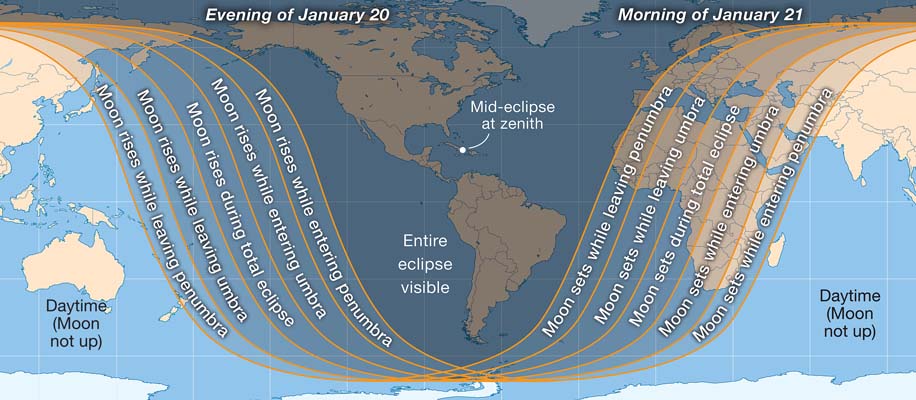
Leah Tiscione / Sky & Telescope
July 2: Total Solar Eclipse
If you're one of the estimated 154 million U.S. adults who watched the solar eclipse on August 21, 2017 — and that's most of us! — you know how incredible these dramatic spectacles can be. Since the Sun escaped another total cover-up in 2018, diehard eclipse-chasers have had to wait nearly two years for their next opportunity to stand in the Moon’s shadow.
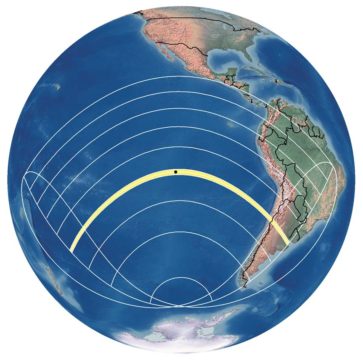
Michael Zeiler / greatamericaneclipse.com
On paper, the solar eclipse of July 2, 2019, offers up to 4m 33s of totality, nearly double that of August 2017. However, to experience all that daylight darkness you’ll need to be bobbing in a remote stretch of the South Pacific Ocean some 700 miles north of Easter Island. Instead, most eclipse chaser’s are eyeing locations in the path’s only real landfall: central Chile and Argentina.
It will be late afternoon when the Moon's umbra crosses these countries at sub-tropical latitudes near 30° south. The bustling coastal town of La Serena, Chile, offers 2m 13s of totality with the Sun about 14° above the northwestern horizon. According to eclipse-weather expert Jay Anderson, this positioning “takes the sting out of what might otherwise be a very cloudy environment.” Some of the very best viewing prospects, statistically speaking, occur a little inland from La Serena along Chile’s picturesque Elqui Valley and on the eastward side of the Andes in western Argentina. More information about this eclipse.
July 16: Partial Lunar Eclipse
Two weeks after July's new Moon (and the solar eclipse it creates), the month's full Moon will dive about two-thirds of the way into Earth's umbral shadow. Unfortunately, with mid-eclipse at 21:31 UT, July 16th's event isn't visible at all from North America. Instead, it's timed best for skywatchers in Europe, Africa, and (before dawn on July 17th) southern Asia and Australia. From South America, you'll see the end of this eclipse after the Moon rises. More information about this eclipse.
December 26: Annular Solar Eclipse
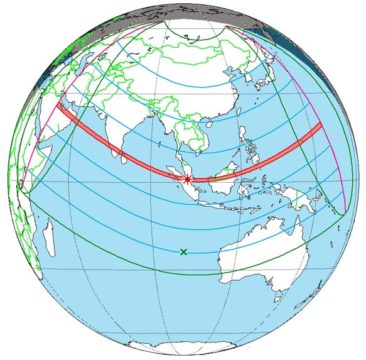
Fred Espenak / eclipsewise.com
The year comes to a dramatic conclusion with an annular eclipse that traces across the Eastern Hemisphere for some 8,000 miles (13,000 km) over the course of 3.3 hours. The event begins at dawn north of Riyadh in Saudi Arabia, with 2m 59s of annularity. Greatest eclipse (with a central duration lasting 3m 39s) comes in eastern Sumatra. Most of Singapore's 5½ million inhabitants are situated just within the path of annularity. Just before it departs Earth's surface, the antumbral shadow races over Guam for 3m 10s.
A partial solar eclipse will be observed across much of southern Asia and Australia. More information about this eclipse.
Looking Ahead to 2020
The recent run of hard-to-reach solar eclipses continues in 2020, with an annular track running across Africa, the southern Saudi Peninsula, and southern Asia on June 21st and a total eclipse again slicing across Chile and Argentina on December 14th. Lunar-eclipse lovers will be both disappointed and stunned, as there'll be four barely-there penumbral eclipses in a 12-month span.
 6
6
Comments
Gerald-Hanner
December 26, 2018 at 10:16 pm
Here is my experience from about 1970, flying between Guam and Honolulu: http://overedicated.blogspot.com/2018/10/oh-places-youll-go.html
You must be logged in to post a comment.
Rod
December 27, 2018 at 10:47 am
Gerald-Hanner, great report at your link and fun read! Thanks for sharing.
You must be logged in to post a comment.
Will
December 28, 2018 at 9:57 am
Kelly, Great article, but what happened to the UK and Ireland on the map?
You must be logged in to post a comment.
J. Kelly BeattyPost Author
December 28, 2018 at 4:10 pm
George... what sharp eyes you have! this was a glitch with our illustration that has now been fixed.
You must be logged in to post a comment.
Karsten Bomholt
December 29, 2018 at 12:58 am
July 16: Partial Lunar Eclipse. From South America, you'll see the end of this eclipse before the Moon rises. ???
You must be logged in to post a comment.
Tim-Robertson
May 15, 2019 at 11:38 am
We just uploaded the observers Notebook podcast highlighting the 2019 Total Solar Eclipse in South America.
https://soundcloud.com/observersnotebook/the-observers-notebook-the-july-2019-total-solar-eclipse
You must be logged in to post a comment.
You must be logged in to post a comment.